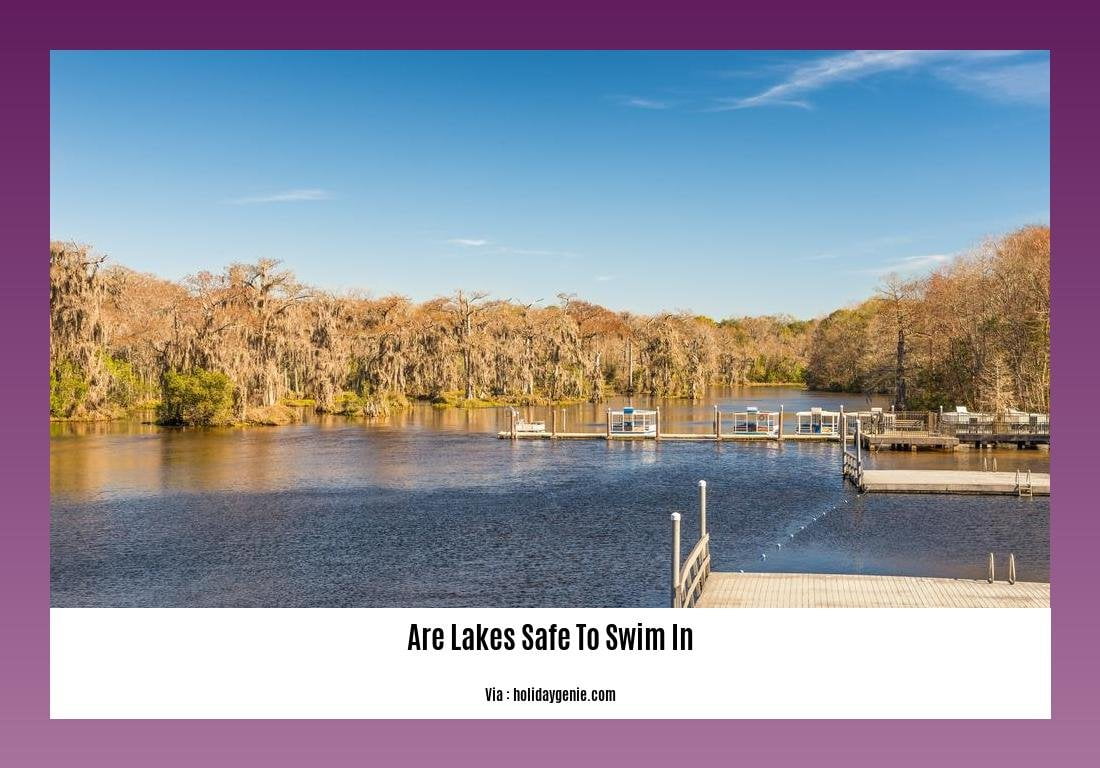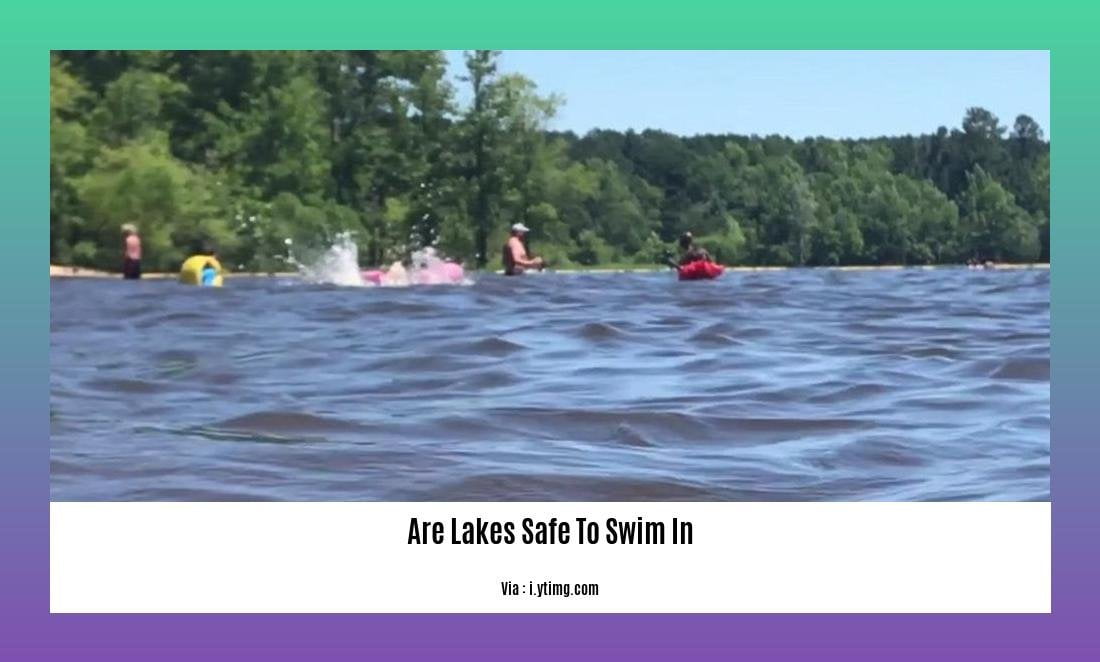Exploring the Safety of Swimming in Lakes: Are Lakes Safe to Swim in? If you’re a water lover, the allure of a sparkling lake on a hot summer day is hard to resist. But before you dive in, it’s crucial to consider the safety of these natural aquatic playgrounds. With potential risks lurking beneath the serene surface, understanding whether lakes are safe for swimming is paramount. As we embark on this exploration, we’ll delve into the factors that influence water safety, from water quality to ecosystem dynamics, and arm you with the knowledge needed to make informed decisions when taking a plunge in lakes.
Key Takeaways:
-
Check online for monitoring and advisories: Before swimming in a lake, check local health department websites or resources like the CDC’s Healthy Swimming to see if the swim area is monitored, under advisory, or closed for health or safety reasons.
-
Observe water condition and algae growth: Look for signs of cleanliness in the water and check for any algae blooms. Algae blooms can indicate poor water quality and potential harm to swimmers.
-
Consider proximity to farms or livestock: The presence of agriculture and livestock near the lake can increase the risk of water contamination, including bacteria and harmful pesticides.
-
Take note of weather patterns: Heavy rain or storms can cause runoff into the lake, potentially introducing pollutants and affecting water quality. It is advisable to wait a few days after heavy rainfall before swimming.
-
Consult with a healthcare provider if necessary: If you have health problems or take medications that may affect your immune system, it is recommended to speak with a healthcare provider before swimming in lakes or natural bodies of water. Some lakes may have high germ levels or contaminants that can pose a risk to individuals with compromised immune systems.
Remember to prioritize safety when swimming in natural bodies of water. Checking for online advisories, observing water quality, considering potential contaminants, staying informed about weather patterns, and consulting with a healthcare provider if needed can help ensure a safe swimming experience.
Are Lakes Safe to Swim In?

When the warm weather hits, many of us are drawn to the serenity and beauty of lakes, eager to take a refreshing dip. But before diving in, it’s important to consider the safety of swimming in lakes. While natural bodies of water can provide a wonderful recreational experience, there are potential risks that need to be taken into account. In this article, we’ll explore the factors that determine whether lakes are safe for swimming and provide you with useful tips to ensure a safe and enjoyable experience.
Checking for Monitoring and Advisories
Before heading to a lake for a swim, it’s essential to check if the swim area is currently monitored, under advisory, or has been closed for health or safety reasons. Online resources such as local health department websites or the CDC’s Healthy Swimming can provide you with this information. By staying informed, you can make an informed decision about the safety of swimming in a particular lake.
Evaluating Water Quality
One of the primary indicators of lake safety is water quality. When you arrive at a lake, take a moment to assess its condition. Look for signs of cleanliness, such as clear water and absence of floating debris. Additionally, keep an eye out for the presence of algae. Algae blooms can indicate poor water quality and pose potential health risks. If you spot an excessive amount of algae or notice a foul odor, it’s best to avoid swimming in that lake.
Considering Potential Contaminants
Another crucial aspect to consider is the presence of agricultural activities or livestock near the lake. Farms in close proximity to the lake can increase the risk of water contamination. Fertilizers, pesticides, and animal waste can all find their way into the water, potentially posing a risk to swimmers. If you notice signs of agricultural activity nearby, it’s advised to approach the lake with caution and consider alternative swimming locations.
Accounting for Weather Patterns
Weather conditions, especially heavy rain or storms, can significantly impact lake water safety. During such weather events, runoff from nearby areas can enter the lake, carrying pollutants and affecting water quality. It’s advisable to wait for a few days after heavy rainfall before swimming in a lake. This precaution allows the water to recover and ensures a safer and more enjoyable swimming experience.
Consulting Healthcare Providers
Individuals with health problems or those taking medications that may affect their body’s ability to fight germs should consult with their healthcare provider before swimming in lakes or other natural bodies of water. Some lakes may harbor high levels of germs or other contaminants that can pose a risk to individuals with compromised immune systems. It’s always better to seek professional advice to ensure your well-being.
When it comes to swimming in lakes, safety should never be compromised. By following these guidelines and prioritizing your health, you can make informed decisions and enjoy the beauty of nature without putting yourself at unnecessary risk. Remember to check for monitoring and advisories, evaluate water quality, consider potential contaminants, account for weather patterns, and consult with healthcare providers if needed. With proper precautions, you can have a memorable and safe swimming experience in lakes.
Sources:
- Visiting Oceans, Lakes, and Rivers | Healthy Swimming – CDC
-
Is Lake Water Safe to Swim in? – Lake Living Guide
- Link to source
Here is a list of active internal links with their respective anchor text and URLs:
- Aquatic Habitat Information: Want to learn more about aquatic habitat information? Click here to explore!
- Are Goldfish Good for Ponds: Are you curious about whether goldfish make good pond inhabitants? Discover the answer by clicking here!
- Are Pond Snails Bad: Are you concerned about pond snails? Find out if they are bad for your pond by clicking here!
The Influence of Human Activities on Lake Water Safety
Lakes are beautiful natural environments that offer a wide range of recreational opportunities. But before taking a dip, it’s important to understand how human activities can impact the safety of lake water. In this article, we’ll explore the influence of human activities on lake water safety, delving into the potential risks and measures that can be taken to ensure a safe swimming experience.
The Threat of Human Impacts
Human activities can have a significant impact on the health of lakes, ultimately affecting the safety of the water. One of the major concerns is the accelerated process of eutrophication, which refers to the excessive accumulation of nutrients in lake ecosystems. Agricultural runoff and sewage discharge are major sources of nutrient loading that can lead to algal blooms and a decline in water quality[^1^]. These blooms not only reduce visibility and aesthetics but can also pose risks to human health, as some algae produce toxins that can harm swimmers.
Other human activities, such as industrial pollution and urban development, can introduce harmful contaminants into lake water. These include pathogens, heavy metals, and synthetic chemicals, all of which can compromise the safety of the water[^2^]. Moreover, the presence of agricultural activities or livestock near lakes can increase the risk of water contamination through fecal bacteria and excess nutrients[^3^].
Mitigating the Risks
Efforts have been made to assess and mitigate the impacts of human activities on lake water safety. Site selection, spatial scale assessment, and comparing non-impacted versus impacted sites are some of the techniques researchers use to understand the influence of human activities on lake ecosystems[^4^]. These studies are crucial for effective conservation and restoration efforts.
In addition to scientific research, there are practical steps that individuals can take to ensure their safety when swimming in lakes. Before diving in, it’s important to check if the swim area is monitored, under advisory, or closed for health or safety reasons. Assessing the water quality of the lake is also essential – look for signs of cleanliness and be cautious of excessive algae or foul odors. It’s also wise to consider weather patterns, as heavy rain or storms can affect water quality through runoff.
Implementing proper safety measures is equally important. The American Red Cross emphasizes the significance of swimming skills and provides resources for both children and adults to be safer in and around water[^5^]. Adhering to water safety rules and guidelines, such as wearing life jackets, can prevent accidents and promote a safe recreational experience.
The Role of Climate Change
Climate change adds another layer of complexity to the issue of lake water safety. Rising temperatures, altered precipitation patterns, and extreme weather events due to climate change have significant impacts on lake ecosystems. These changes can affect water quality, exacerbate nutrient loading, and promote the growth of harmful algal blooms[^6^]. Thus, effective management strategies and conservation efforts are crucial to safeguard lake health in the face of ongoing global change.
Key Takeaways:

- Human activities, such as nutrient loading and pollution, can have a negative impact on lake water safety.
- Nutrient loading from sources like agricultural runoff and sewage discharge can lead to algal blooms and reduced water quality.
- Industrial pollution, urban development, and agricultural activities near lakes can introduce harmful contaminants into the water.
- Conservation and restoration efforts, including scientific research, can help mitigate the risks posed by human activities.
- Individuals should check swim area advisories, assess water quality, and follow water safety rules to ensure their safety.
- Climate change exacerbates the existing stressors on lakes and requires effective management and conservation strategies to protect water safety.
[^1^]: The Colby College Community Web – Lake Health and Human Impact
[^2^]: SAGE Journals – First Human Impacts and Responses of Aquatic Systems: A Review
[^3^]: American Red Cross – Lake and River Swimming Safety
[^4^]: Dubois, N., Saulnier-Talbot, É., Mills, K., Gell, P., Battarbee, R., (2018). First human impacts and responses of aquatic systems: A review. SAGE Journals. Retrieved from
[^5^]: American Red Cross – Lake and River Swimming Safety
[^6^]: ScienceDaily – Lakes are Changing Worldwide: Human Activities to Blame
The Role of Ecological Factors in Determining Lake Swimming Safety
Lakes are a popular destination for swimming and water sports, but it’s important to consider the safety factors before taking a dip. While many factors contribute to lake swimming safety, ecological factors play a significant role in determining the overall health and safety of the lake. By understanding the influence of ecological factors, we can make informed decisions and prioritize our well-being while enjoying lakes.
Understanding Eutrophication and Ecological Health
One crucial factor to consider is the ecological health of the lake. Lakes can naturally progress towards eutrophication, a process where excessive nutrients, such as nitrogen and phosphorus, lead to algal blooms and reduced water quality[^1^]. Human activities, particularly nutrient loading from agricultural runoff and sewage discharge, can accelerate this process, causing negative ecological impacts and decreased biodiversity[^1^].
Zooplankton Simpson Diversity Index: An Indicator of Lake Ecosystem Health
A key ecological indicator of lake health is the Zooplankton Simpson diversity index. This index measures the diversity and abundance of small aquatic organisms called zooplankton, which are vital components of the lake ecosystem[^2^]. High Simpson diversity index values indicate a healthier ecosystem, while lower values may suggest ecological deterioration[^2^]. By monitoring this indicator, researchers can assess the overall health and ecological functioning of lakes.
The Role of Water Quality in Lake Swimming Safety
Water quality is another crucial ecological factor that directly affects lake swimming safety. High levels of nutrients, such as nitrogen and phosphorus, can contribute to excessive algae growth and harmful algal blooms, posing health risks to swimmers[^1^]. Additionally, the presence of pollutants from human activities, such as agricultural runoff or industrial waste, can further degrade water quality, making it unsafe for swimming[^3^]. Regular monitoring of water quality parameters, such as chlorophyll a and ammonia nitrogen levels, helps assess the safety of swimming in lakes.
The Impact of Human Activities on Lake Water Safety
Human activities can have direct consequences for lake water safety. For example, agricultural activities and livestock farming near the lake can increase the risk of water contamination, limiting its safety for swimming[^3^]. Heavy rain or storms can also impact water quality by causing runoff, carrying pollutants and sediments into the lake[^3^]. Therefore, it is essential to consider anthropogenic influences when evaluating the safety of swimming in lakes.
The Interplay Between the Catchment Area and Lake Health
Lakes do not exist in isolation from their surroundings. The catchment area surrounding a lake plays a significant role in determining its health and water quality. Landscape changes, such as deforestation or urbanization, can affect the amount and quality of water that enters the lake[^4^]. Chemical processes within the lake can also be influenced by the interplay between the catchment area and the lake itself[^4^]. Therefore, understanding these interactions is crucial for assessing lake swimming safety.
Key Takeaways:
- Ecological factors, such as eutrophication and water quality, play a crucial role in determining the safety of swimming in lakes.
- Nutrient loading from human activities can accelerate eutrophication, leading to algal blooms and reduced water quality.
- Monitoring the Zooplankton Simpson diversity index helps assess the ecological health of lakes.
- Water quality parameters, such as chlorophyll a and ammonia nitrogen levels, can indicate the safety of swimming in lakes.
- Human activities, such as agriculture and urbanization, can impact lake water quality and safety.
- The catchment area surrounding a lake influences its health and water quality.
- Considering these ecological factors is important for making informed decisions about swimming in lakes.
Sources:
[^1^]: Lake Health and Human Impact
[^2^]: Ecological indicators for aquatic biodiversity, ecosystem functions
[^3^]: Lake and River Swimming Safety
[^4^]: Lakes are changing worldwide: Human activities to blame
Precautions and Measures to Ensure a Safe and Enjoyable Swimming Experience in Lakes
Lakes offer a refreshing and thrilling experience for swimmers, but it’s essential to take precautions and measures to ensure a safe and enjoyable swimming experience. By following these guidelines, you can minimize risks and fully enjoy the magic of swimming in lakes.
Swim with Company for Added Safety
Swimming alone in a lake can be risky, especially if you encounter unexpected challenges. To enhance your safety, always swim with a buddy or a group of friends. Having someone nearby ensures someone can assist or seek help if needed.
Know Your Limits and Swimming Abilities
Understanding your own swimming abilities and being honest with yourself is crucial for staying safe in lakes. If you consider yourself a beginner or have limited swimming skills, stick to shallow areas or designated swimming zones. Avoid venturing into deep waters or areas beyond your comfort level to prevent accidents and ensure a secure swimming experience.
Avoid Alcohol and Stay Sober
Refrain from consuming excessive amounts of alcohol before or during swimming in lakes. Alcohol impairs judgment and coordination, increasing the risk of accidents or mishaps in the water. Stay sober to ensure clarity of mind and better control over your swimming abilities.
Wear Appropriate Safety Gear
When swimming in deeper areas or engaging in water sports activities, it is crucial to wear appropriate safety gear such as life jackets. Life jackets provide buoyancy and can potentially save lives in unpredictable situations. Don’t hesitate to use them whenever necessary, as safety should always be a top priority.
Adhere to Safety Measures
Follow pool rules and regulations set forth by lake management or lifeguards. These rules are designed to ensure the safety of swimmers and maintain order in the swimming area. By adhering to these guidelines, you contribute to a safe and enjoyable swimming environment for everyone.
Seek Lifeguard or Designated Swimming Areas
Before swimming in a lake, make sure a lifeguard is present or that there is a designated swimming area. Lifeguards are trained to respond to emergencies and provide immediate assistance if needed. Swimming in monitored areas enhances safety and minimizes potential risks.
Ensure Optimal Safety Regardless of Experience Level
Regardless of your swimming experience level, it is essential to prioritize safety. Take precautions by being aware of your surroundings, staying mindful of the current, and avoiding risky behaviors such as diving into unknown waters or swimming in unfamiliar places. Focusing on safety ensures an enjoyable and worry-free swimming experience.
Key Takeaways:
- Swim with company to enhance safety.
- Know your swimming abilities and stick to shallow areas or designated zones.
- Avoid alcohol to maintain clarity of mind and coordination.
- Wear appropriate safety gear, such as life jackets, when necessary.
- Adhere to pool rules and regulations to ensure a safe environment.
- Seek lifeguard presence or designated swimming areas for added security.
- Prioritize safety regardless of experience level to have an enjoyable swim.
SOURCES:
– NCESC – How do you know if a lake is safe to swim?
– Just Swim – 24 Safety Precautions In Swimming For Beginners And Pros
FAQ
Q1: How can I determine if a lake is safe to swim in?
A1: To determine if a lake is safe to swim in, it is recommended to check online for any advisories or closures, observe the condition of the water, consider the presence of farms or livestock nearby, be aware of weather patterns, and consult with a healthcare provider if you have any health concerns.
Q2: What should I look for to assess the condition of the water before swimming in a lake?
A2: Before swimming in a lake, you should look for signs of cleanliness, observe if there is any algae growing in the lake, and be aware that algae blooms can be a sign of poor water quality that may be harmful to swimmers.
Q3: How does the proximity of farms or livestock affect the safety of swimming in a lake?
A3: The presence of farms or livestock near a lake can increase the risk of water contamination. This includes the potential presence of bacteria and harmful pesticides, which can affect the safety of swimming in the lake.
Q4: Why is it important to consider weather patterns before swimming in a lake?
A4: Heavy rain or storms can cause runoff from nearby areas into the lake, potentially introducing pollutants and affecting water quality. It is advisable to wait for a few days after heavy rainfall before swimming in the lake to ensure safer conditions.
Q5: Should individuals with health problems or taking medications be cautious when swimming in lakes?
A5: Yes, individuals with health problems or taking medications that may affect their immune system’s ability to fight germs should consult with their healthcare provider before swimming in lakes or other natural bodies of water. Some lakes may have high levels of germs or contaminants that can pose a risk to individuals with compromised immune systems.
- Unveiling Bernhard Caesar Einstein’s Scientific Achievements: A Legacy in Engineering - July 15, 2025
- Uncover who is Jerry McSorley: CEO, Family Man, Business Success Story - July 15, 2025
- Discover Bernhard Caesar Einstein’s Scientific Contributions: Unveiling a Legacy Beyond Einstein - July 15, 2025















